Mengyu Liu
Low-Complexity Iterative Precoding Design for Near-field Multiuser Systems With Spatial Non-Stationarity
Jan 18, 2025Abstract:Extremely large antenna arrays (ELAA) are regarded as a promising technology for supporting sixth-generation (6G) networks. However, the large number of antennas significantly increases the computational complexity in precoding design, even for linearly regularized zero-forcing (RZF) precoding. To address this issue, a series of low-complexity iterative precoding are investigated. The main idea of these methods is to avoid matrix inversion of RZF precoding. Specifically, RZF precoding is equivalent to a system of linear equations that can be solved by fast iterative algorithms, such as random Kaczmarz (RK) algorithm. Yet, the performance of RK-based precoding algorithm is limited by the energy distributions of multiple users, which restricts its application in ELAA-assisted systems. To accelerate the RK-based precoding, we introduce the greedy random Kaczmarz (GRK)-based precoding by using the greedy criterion-based selection strategy. To further reduce the complexity of the GRK-based precoding, we propose a visibility region (VR)-based orthogonal GRK (VR-OGRK) precoding that leverages near-field spatial non-stationarity, which is characterized by the concept of VR. Next, by utilizing the information from multiple hyperplanes in each iteration, we extend the GRK-based precoding to the aggregation hyperplane Kaczmarz (AHK)-based pecoding algorithm, which further enhances the convergence rate. Building upon the AHK algorithm, we propose a VR-based orthogonal AHK (VR-OAHK) precoding to further reduce the computational complexity. Furthermore, the proposed iterative precoding algorithms are proven to converge to RZF globally at an exponential rate. Simulation results show that the proposed algorithms achieve faster convergence and lower computational complexity than benchmark algorithms, and yield very similar performance to the RZF precoding.
Addressing the Mutual Interference in Uplink ISAC Receivers: A Projection Method
Aug 29, 2024


Abstract:Dual function radar and communication (DFRC) is a promising research direction within integrated sensing and communication (ISAC), improving hardware and spectrum efficiency by merging sensing and communication (S&C) functionalities into a shared platform. However, the DFRC receiver (DFRC-R) is tasked with both uplink communication signal detection and simultaneously target-related parameter estimation from the echoes, leading to issues with mutual interference. In this paper, a projection-based scheme is proposed to equivalently transform the joint signal detection and target estimation problem into a joint signal detection process across multiple snapshots. Compared with conventional successive interference cancellation (SIC) schemes, our proposed approach achieves a higher signal-to-noise ratio (SNR), and a higher ergodic rate when the radar signal is non-negligible. Nonetheless, it introduces an ill-conditioned signal detection problem, which is addressed using a non-linear detector. By jointly processing an increased number of snapshots, the proposed scheme can achieve high S&C performance simultaneously.
Automating Weak Label Generation for Data Programming with Clinicians in the Loop
Jul 10, 2024Abstract:Large Deep Neural Networks (DNNs) are often data hungry and need high-quality labeled data in copious amounts for learning to converge. This is a challenge in the field of medicine since high quality labeled data is often scarce. Data programming has been the ray of hope in this regard, since it allows us to label unlabeled data using multiple weak labeling functions. Such functions are often supplied by a domain expert. Data-programming can combine multiple weak labeling functions and suggest labels better than simple majority voting over the different functions. However, it is not straightforward to express such weak labeling functions, especially in high-dimensional settings such as images and time-series data. What we propose in this paper is a way to bypass this issue, using distance functions. In high-dimensional spaces, it is easier to find meaningful distance metrics which can generalize across different labeling tasks. We propose an algorithm that queries an expert for labels of a few representative samples of the dataset. These samples are carefully chosen by the algorithm to capture the distribution of the dataset. The labels assigned by the expert on the representative subset induce a labeling on the full dataset, thereby generating weak labels to be used in the data programming pipeline. In our medical time series case study, labeling a subset of 50 to 130 out of 3,265 samples showed 17-28% improvement in accuracy and 13-28% improvement in F1 over the baseline using clinician-defined labeling functions. In our medical image case study, labeling a subset of about 50 to 120 images from 6,293 unlabeled medical images using our approach showed significant improvement over the baseline method, Snuba, with an increase of approximately 5-15% in accuracy and 12-19% in F1 score.
Beamforming Design for Double-Active-RIS-aided Communication Systems with Inter-Excitation
Mar 17, 2024Abstract:In this paper, we investigate a double-active-reconfigurable intelligent surface (RIS)-aided downlink wireless communication system, where a multi-antenna base station (BS) serves multiple single-antenna users with both double reflection and single reflection links. Due to the signal amplification capability of active RISs, the mutual influence between active RISs, which is termed as the "inter-excitation" effect, cannot be ignored. Then, we develop a feedback-type model to characterize the signal containing the inter-excitation effect. Based on the signal model, we formulate a weighted sum rate (WSR) maximization problem by jointly optimizing the beamforming matrix at the BS and the reflecting coefficient matrices at the two active RISs, subject to power constraints at the BS and active RISs, as well as the maximum amplification gain constraints of the active RISs. To solve this non-convex problem, we first transform the problem into a more tractable form using the fractional programming (FP) method. Then, by introducing auxiliary variables, the problem can be converted into an equivalent form that can be solved by using a low-complexity penalty dual decomposition (PDD) algorithm. Finally, simulation results indicate that it is crucial to consider the inter-excitation effect between active RISs in beamforming design for double-active-RIS-aided communication systems. Additionally, it prevails over other benchmark schemes with single active RIS and double passive RISs in terms of achievable rate.
Joint Beamforming Design for Double Active RIS-assisted Radar-Communication Coexistence Systems
Feb 07, 2024



Abstract:Integrated sensing and communication (ISAC) technology has been considered as one of the key candidate technologies in the next-generation wireless communication systems. However, when radar and communication equipment coexist in the same system, i.e. radar-communication coexistence (RCC), the interference from communication systems to radar can be large and cannot be ignored. Recently, reconfigurable intelligent surface (RIS) has been introduced into RCC systems to reduce the interference. However, the "multiplicative fading" effect introduced by passive RIS limits its performance. To tackle this issue, we consider a double active RIS-assisted RCC system, which focuses on the design of the radar's beamforming vector and the active RISs' reflecting coefficient matrices, to maximize the achievable data rate of the communication system. The considered system needs to meet the radar detection constraint and the power budgets at the radar and the RISs. Since the problem is non-convex, we propose an algorithm based on the penalty dual decomposition (PDD) framework. Specifically, we initially introduce auxiliary variables to reformulate the coupled variables into equation constraints and incorporate these constraints into the objective function through the PDD framework. Then, we decouple the equivalent problem into several subproblems by invoking the block coordinate descent (BCD) method. Furthermore, we employ the Lagrange dual method to alternately optimize these subproblems. Simulation results verify the effectiveness of the proposed algorithm. Furthermore, the results also show that under the same power budget, deploying double active RISs in RCC systems can achieve higher data rate than those with single active RIS and double passive RISs.
Fulfilling Formal Specifications ASAP by Model-free Reinforcement Learning
Apr 25, 2023Abstract:We propose a model-free reinforcement learning solution, namely the ASAP-Phi framework, to encourage an agent to fulfill a formal specification ASAP. The framework leverages a piece-wise reward function that assigns quantitative semantic reward to traces not satisfying the specification, and a high constant reward to the remaining. Then, it trains an agent with an actor-critic-based algorithm, such as soft actor-critic (SAC), or deep deterministic policy gradient (DDPG). Moreover, we prove that ASAP-Phi produces policies that prioritize fulfilling a specification ASAP. Extensive experiments are run, including ablation studies, on state-of-the-art benchmarks. Results show that our framework succeeds in finding sufficiently fast trajectories for up to 97\% test cases and defeats baselines.
Sparse Spatial Attention Network for Semantic Segmentation
Sep 04, 2021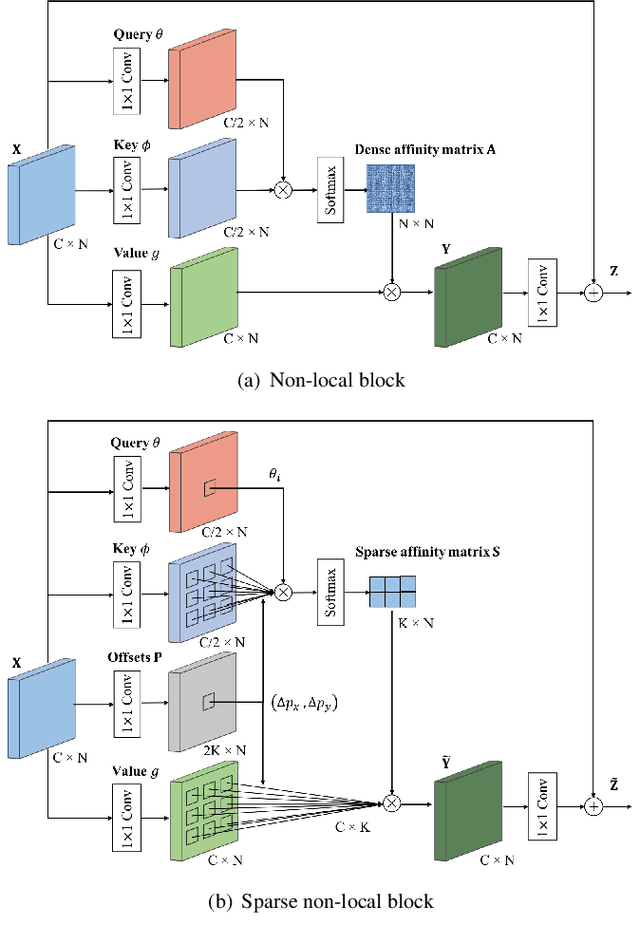
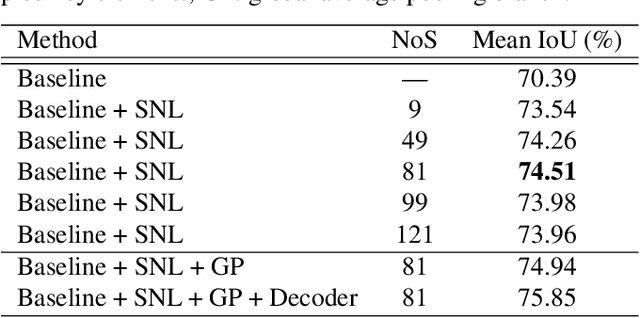
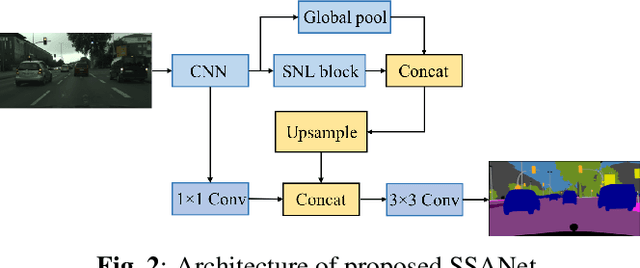
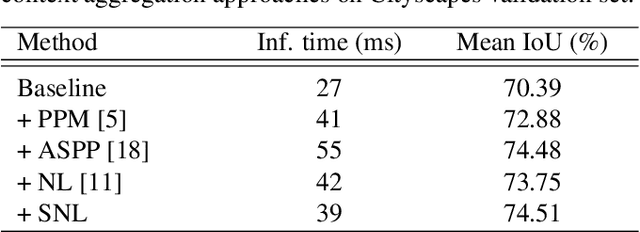
Abstract:The spatial attention mechanism captures long-range dependencies by aggregating global contextual information to each query location, which is beneficial for semantic segmentation. In this paper, we present a sparse spatial attention network (SSANet) to improve the efficiency of the spatial attention mechanism without sacrificing the performance. Specifically, a sparse non-local (SNL) block is proposed to sample a subset of key and value elements for each query element to capture long-range relations adaptively and generate a sparse affinity matrix to aggregate contextual information efficiently. Experimental results show that the proposed approach outperforms other context aggregation methods and achieves state-of-the-art performance on the Cityscapes, PASCAL Context and ADE20K datasets.
Feature Pyramid Encoding Network for Real-time Semantic Segmentation
Sep 18, 2019



Abstract:Although current deep learning methods have achieved impressive results for semantic segmentation, they incur high computational costs and have a huge number of parameters. For real-time applications, inference speed and memory usage are two important factors. To address the challenge, we propose a lightweight feature pyramid encoding network (FPENet) to make a good trade-off between accuracy and speed. Specifically, we use a feature pyramid encoding block to encode multi-scale contextual features with depthwise dilated convolutions in all stages of the encoder. A mutual embedding upsample module is introduced in the decoder to aggregate the high-level semantic features and low-level spatial details efficiently. The proposed network outperforms existing real-time methods with fewer parameters and improved inference speed on the Cityscapes and CamVid benchmark datasets. Specifically, FPENet achieves 68.0\% mean IoU on the Cityscapes test set with only 0.4M parameters and 102 FPS speed on an NVIDIA TITAN V GPU.
Cross Attention Network for Semantic Segmentation
Jul 25, 2019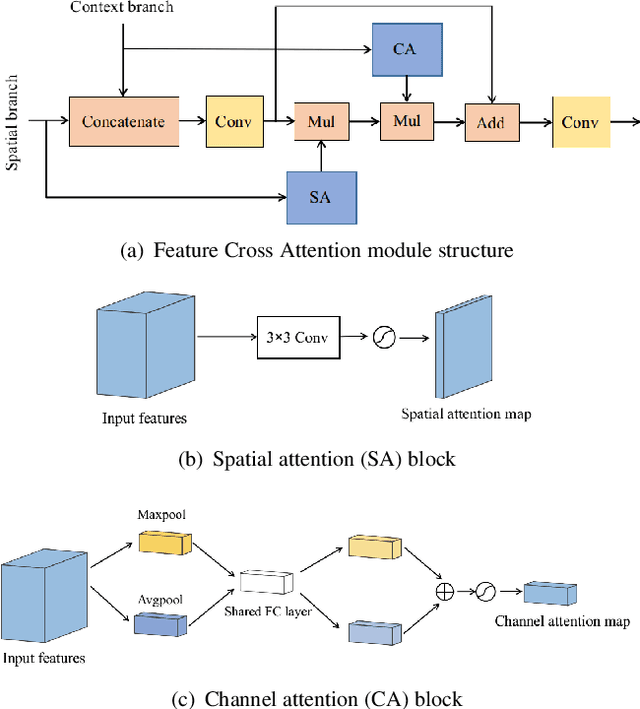
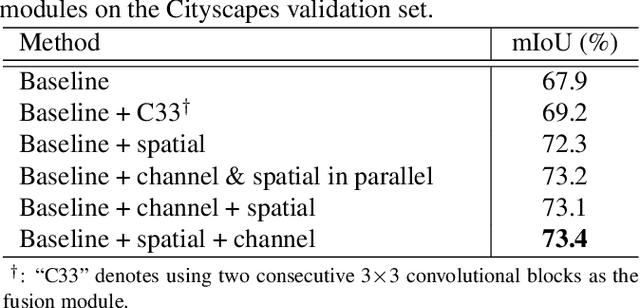
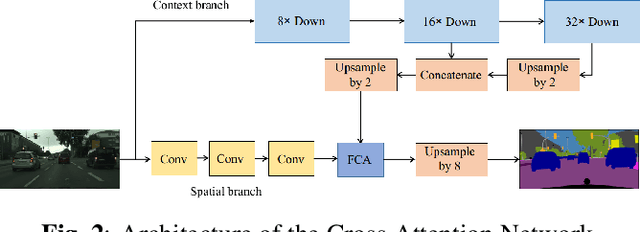
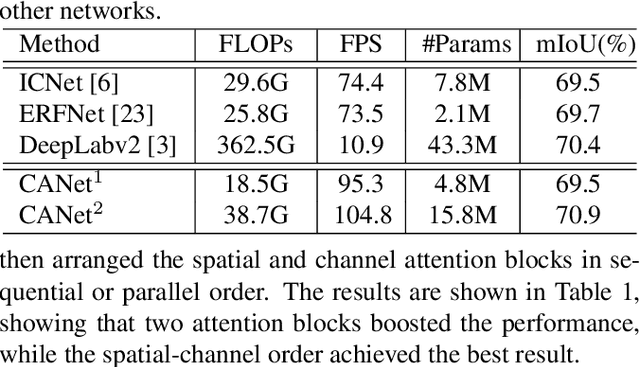
Abstract:In this paper, we address the semantic segmentation task with a deep network that combines contextual features and spatial information. The proposed Cross Attention Network is composed of two branches and a Feature Cross Attention (FCA) module. Specifically, a shallow branch is used to preserve low-level spatial information and a deep branch is employed to extract high-level contextual features. Then the FCA module is introduced to combine these two branches. Different from most existing attention mechanisms, the FCA module obtains spatial attention map and channel attention map from two branches separately, and then fuses them. The contextual features are used to provide global contextual guidance in fused feature maps, and spatial features are used to refine localizations. The proposed network outperforms other real-time methods with improved speed on the Cityscapes and CamVid datasets with lightweight backbones, and achieves state-of-the-art performance with a deep backbone.
 Add to Chrome
Add to Chrome Add to Firefox
Add to Firefox Add to Edge
Add to Edge